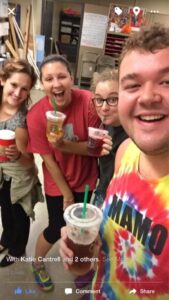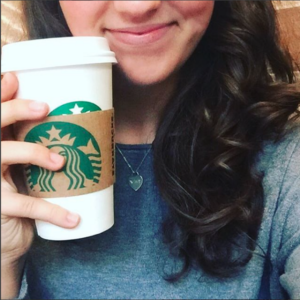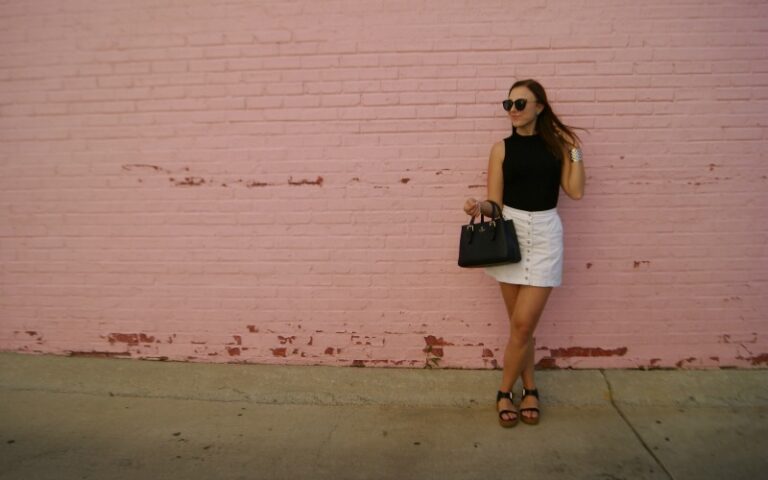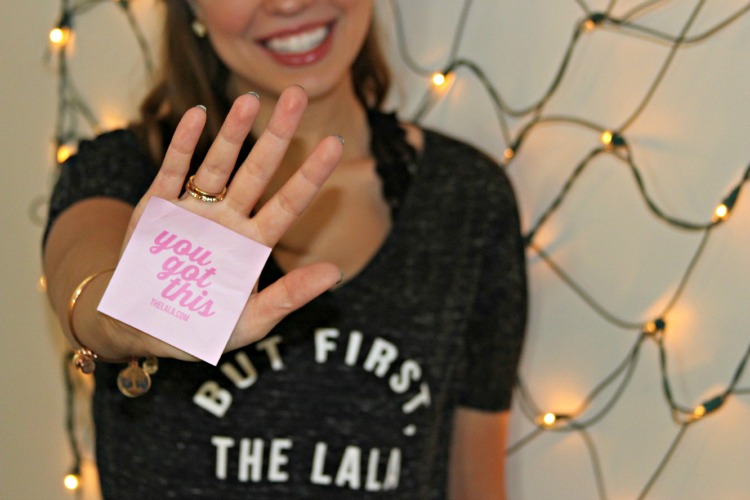Starbucks and Selfies
It’s an understatement to say that Starbucks is successful. The company is starting to take over the American Northeast, where Dunkin Donuts had previously reigned supreme and unchallenged, as well as moving across the globe. My first time visiting Europe, there were maybe three Starbucks locations that I encountered, but when I studied abroad in Madrid in 2014, they seemingly were everywhere. I’ve heard similar stories from friends who have studied in other European countries and China, so it’s no surprise that there are over 22,000 Starbucks locations in 67 countries.
Starbucks has infiltrated our day to day lives. Starbucks selfies pop up daily on my Instagram, Facebook, and Twitter feeds as well as on my friends’ Snapchat MyStories. Going outside my own social network, searching #StarbucksSelfie on Instagram pulls up hundreds of millions of selfies with the classic white (or holiday red) cup, published by people of all ages and walks of life, and that’s just the posts featuring the hashtag.
Is Starbucks coffee really that amazing?
I love Starbs as much as the next sorority girl, but let’s be real. If you want impeccable coffee, you go to a gourmet café, not the Starbucks down the street.
The secret to Starbucks’ success is its immaculate branding. No one cares if you’re drinking coffee, they care that you’re drinking Starbucks. Think about it. Have you ever seen anyone at Starbucks take a picture of the actual coffee? Instead, the branded material gets posted all over social media, generally in the form of selfies.
Selfies are in a way a self-portrait. They show who you are, but they’re highly idealized. You rarely see a selfie on social media that hasn’t been handpicked and filtered prior to posting. This behavior is explained by the dramaturgical theory of self. The theory says that “we are always putting on a mask, performing different roles or selves on a ‘stage’ with ‘props’ for an intended audience” (Humphreys, p. 86). By choosing to take a selfie with your Starbucks, you are inherently connecting your identity with the Starbucks brand to portray a vision of yourself. The iconic cup is your “prop” and your “role” is that of the Starbucks regular. What does this mean in terms of your self presentation?
Let’s first examine the role of the “prop.” The branded Starbucks cup in your selfie tells everyone in your social network that you just went to Starbucks, spent ~$4 on coffee you could have gotten for half the cost elsewhere, and are darn proud. Why is this coffee so special that it deserves a spot in your selfie? The answer: it’s your drink. People feel a connection to their signature drink that is made exactly the way they want. For example, my go-to is a nonfat Chai latte, something that I share frequently on Snapchat. Your drink takes on a part of your identity, so it makes sense that it’s featured in so many selfies.
As important as your relationship with your drink is, interpersonal relationships are arguably more important to Starbucks. Yes, you go to Starbucks for the average quality beverages, but you really go for Starbucks’ real product: connection.
Starbucks is a gathering place where people go to work, to study, to catch up with friends, etc. The people there are seen as successful, intelligent, hard-working, creative, and trendy, just to name a few. In short, Starbucks people are “cool.” People who don’t even like coffee go to Starbucks just to share in that identity. By playing the “role” of a Starbucks regular, you are aligning yourself with those “cool” people you see at Starbucks. You are telling your social network that you, too, are smart, diligent, and “cool.”
https://www.instagram.com/p/BBDTQJhF36_/?taken-by=laurenemorton
This selfie was posted on Instagram by my friend Lauren prior to her final interview at a Chicago firm. She is connecting herself with the hard-working, go-getter persona associated with the Starbucks brand, as seen in her caption.
This group selfie was posted on Facebook by my friend Conrad after he and others went on a Starbucks run. Going to Starbucks served primarily as a social activity for them, showing again how Starbucks provides and facilitates connections.
This selfie was posted on my friend Betsy’s Snapchat MyStory. It followed a series of snaps she posted of her preparing for a terrible biology exam. With this context, her Snapchat friends can see that she is enjoying the Starbucks as a reward for her time and effort spent studying. This fits with the Starbucks brand attracting intelligent and hard-working customers.
This selfie was posted on Instagram by my friend Tori. I was with her as she took it. She said she wanted the picture to look “artsy.” Her “non-basic” shot goes along with the idea of a creative and unique customer base.
By using the Starbucks cup as a “prop” and trying to play the “role” that society gives to Starbucks customers in selfies, everyday people are trying to portray an idealized version of themselves through connecting to the Starbucks brand. All of these selfies just draw even more admiration (and sales) to Starbucks, with its specialized drinks and “cool” in-group of customers. I learned recently from a Starbucks employee that baristas are taught to spell your name incorrectly in the hopes that you post about it and make others in your social network think, hmm, maybe I should go get a Starbucks. With this knowledge, I’m sure Starbucks is well aware of the power that selfies with their branded products have, and will do anything, even misspelling your name, to make you click “post.”
As for me, I’m hoping this selfie makes me look like I am working hard on schoolwork… In reality, I was taking the newest Pottermore house sorting quiz as I snapped this. I’m still a Slytherin, in case you were wondering. At least my idealized selfie makes me look focused and studious!
Citation:
Humphreys, A. (2016). Social Media: Enduring Principles. New York: Oxford University Press.









